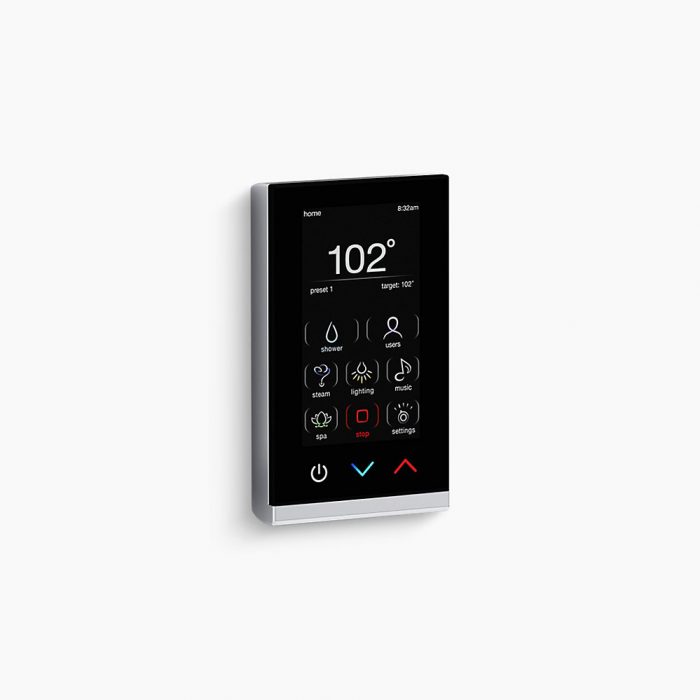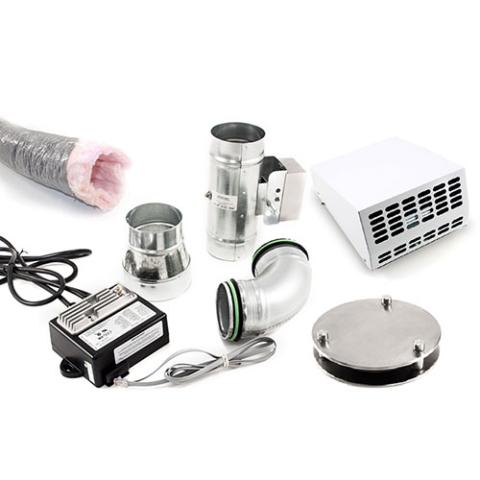
As a construction journalist, I am on seemingly every building material manufacturer’s mailing list. When a big trade show like the International Builders’ Show approaches, my inbox fills with promotional emails. Many, if not most, of the emails are about luxe products—fancy faucets, Corian countertops, high-end appliances, etc. I could not care less about these things, so I was surprised to discover my interest in an option from the Delta Faucet Company, which I learned about at this year’s IBS, where I did a little digging on behalf of GBA.
I was invited to preview their new Showersense, a customizable, Wi-Fi-enabled shower valve that looks like an iPhone and operates with touch control. It offers connectivity to virtual assistants, so I suppose you could order Alexa to turn the thing on. The gizmo had no appeal for me until Rachel Day, a Delta rep, segued into talking about the company’s new Steamscape Steam Shower, set to hit the market in summer 2023. It uses the same controller.
I imagined myself using the steam bath-shower combination and thought I would linger longer, luxuriating in the heat on a winter morning. I could even shave in the steam and, I imagined, waste additional gallons of water in the process. So, I asked, “How much water does it use for normal steaming?” It turns out that a 20-min. steam session uses less than 1 gal. of water. Suddenly, this indulgence might be given a green angle, as an average 10-min. shower with a standard shower head uses about 25 gal., according to the Environmental Protection Agency. My showers are never long, but I could spend 20 min. (or more) in a private spa.
Other concerns I raised with the Delta rep were not addressed as readily. They included the handling of the extra bathroom humidity and the energy consumed by the steam generator.
Delta got back to me by email to say they size steam-generating units by cubic feet, and they sent me a table of sizes. The most practical is the 7.5 kW unit, which can supply steam to a shower measuring 250 cu. ft. (5 ft. by 6 ft. by 8 ft. tall is 160 cu. ft.). The company advises upgrading the bathroom supply lines from the standard 1/2 in. “We recommend 3/4-in. supply lines to ensure an adequate water supply to your generator. As with other models, 1/2 in. will suffice, but this increases the potential for additional system noise. To avoid this, we recommend the larger diameter,” explained Delta spokesperson Allyson Brunner. Their steam shower units start at $2100.
Kohler makes a steam shower too
The Kohler steam generator also consumes about 1 gal. in 20 min. It will operate as a standalone with their steam-only “Invigoration Controller” or paired with the company’s digital interface DTV+ system that also controls their luxury, multi-function shower.

Huston Sprang, senior product manager at Kohler, explained, “The ideal height for a steam shower is 8 ft., so if a user goes above that height, the steam generator size needs to increase.” According to Sprang, a 4 ft. by 5 ft. shower 8 ft. high will pair well with a 9 kW steam generator consuming 60 amps, or about 4.8 kW during 20 min.—a little less than a dollar in Texas.
When I installed a Kohler digital shower system last year, I had to upgrade my supply lines from 1/2 in. to 1 in., almost like a lawn sprinkler system. So, I questioned the steam unit. “There isn’t special plumbing needed,” said Sprang, “but we require 90° copper fittings to supply the generator. For optimum performance, the steam generator must be installed within 25 ft. of the steam head. To ensure proper operation, we recommend water supply be tested before operating the steam generator to ensure a Hardness of 60 ppm (3.4 gpg) max with a Total Alkalinity of 150 ppm (8.8 gpg).”
When I asked Sprang about the cost of Kohler’s steam shower all in, he said, “There’s a wide range as our 5 kW list price is $3,023.85 to our 30 kW runs $9,584.05. Then the controller price can vary depending on whether you use the steam-only controller or DTV+. For example, if a user selected a 9 kW generator and the steam-only controller, the list price would be $4,530.95. This would include the generator, controller, and a round steam head.”

Although neither Delta nor Kohler specify the bathroom exhaust fan, it seems evident that with a steam source, you will need a high-quality unit, preferably with a humidistat, to clear any excess water vapor that might escape the enclosure. SteamSaunaBath suggests fans made for home steam rooms. The supplier recommends the Bathology brand, including several models installed outside the steam enclosure and the Atmospheric 410 steam shower exhaust installed inside the steam bath. Prices range from $508 to $2336.
Conclusion
Luxury is rarely compatible with conservation—consider the electric GMC Hummer or 10,000-sq.-ft. net-zero homes of the very wealthy. But a steam shower that consumes 1 gal. of water seems like a temperate indulgence, if you can afford it. I cannot, but I admit I’d like to have one for when the weather is brisk, and a long, warm steam bath would feel good.
________________________________________________________________________
Fernando Pagés Ruiz is a builder and an ICC-certified residential building inspector active in code development.
Weekly Newsletter
Get building science and energy efficiency advice, plus special offers, in your inbox.











16 Comments
This seems like classic green washing to me. The first practical question I have is can you even get clean in a steam shower? Using their math, a 5 minute shower is going to use up less than a litre of water, only a tiny fraction of which is going to come into contact with your body. So basically, try to picture washing and rinsing your hair and then the rest of your body using a couple of tablespoons of water.
So this steam shower "saves" a lot of water versus a conventional shower, but without doing anything practical and using similar amounts of energy.
The fact that they recommend a bigger supply line despite claiming to use 98% less water per unit time is also a red flag that something isn't quite what it seems.
This is just another luxury appliance masquerading as environmentally friendly.
Not to mention power requirements. Although only 1 gallon is used, it uses about as much energy as a 10 minute shower with a 2.5gpm shower head. It takes a lot of energy to turn water that is 212*F from liquid to vapor. 7760 BTUs for that gallon of water, and that's once it has already heated to 212*F.
You sweat in a steam room. This has nothing to do with a shower or getting clean. Also, most people turn these on and get the steam going way before getting in. Otherwise your sitting in a cold room.
mgensler,
"You sweat in a steam room. This has nothing to do with a shower or getting clean."
Which leaves me a bit confused. If this is a new, unrelated activity, what water is it saving?
If you're wanting to sit in a hot steamy shower for 20 minutes, using a steam generator to keep it hot uses less water, but a lot of energy.
I think that idea is that if you start each day with a calming steam shower you are less likely to become obsessed having a perfect lawn or a spotlessly clean car, and so you'll save the water that might have been used for watering the lawn and washing the car.
It's a bit unclear what the steam shower functionality is offsetting in this scenario. I'd guess it would be a possibility for allowing more comfortable "Navy showers" (using water for an initial rinse, shutting the water off for lathering up, then using the water for a final rinse)
For places like California or the southwest where its much easier to offset energy use than water consumption, something like this could be an option. Although at a few grand plus maintenance I can't imagine how long the payback period would be.
A similar option that has intrigued me is using some form of radiant heat to provide thermal comfort during Navy shower which should come in at a lower price and use no water.
Yes, that can make sense. But only works if the user wants to do it that way.
Perhaps they are touting water conservation as an amenity, which, as pointed out above, seems to be greenwashing (pun intended), as there are two issues:
First, a steam session does not replace a shower. So the only water conservation going on here is if the 20 minute steam session that uses 1 gallon of water is in lieu of a 20 minute shower. In that case, yes it is saving some quantity of water as well as the energy used to heat that water (more below)
Second, water is not the only resource. Per the article, the 9 kw unit uses 4.8 kw in a 20 minute steam shower. Considering I operate my house, heat and cooling included, for an average of about 25 kw/day, that is almost 20% added to my daily total power use.
Back to the water calculations: While a "standard" shower head does indeed use 2.5 gpm as the article notes, there are few places in the US whose codes allow installation of a "standard" shower head. Since California requires their shower heads use no more than 1.8 gpm, almost all the shower heads sold by most manufacturers meet that requirement. Only 165 of the 610 shower heads available on the Delta site use over 1.75 gpm, and many of those are either dual head showers or discontinued products (why they are still on their site is odd). So the comparison should really be to an average 1.75 gpm head. Still, if the showering person spends an extra 20 minutes just luxuriating in the flowing water, they are consuming 35 extra gallons plus the energy to heat that vs this steam thing using, in that same 20 minutes, consuming 1 gallon + 4.8kw.
...and we have not even begun to take into account how much longer the fan needs to run to evacuate the steam, etc. etc.
When considering whether a product is good for the environment or "green" we really need to consider how it will be used by the vast majority of everyday users, not just folks who are very interested in being green. By that standard I question just how good this product will be. For one thing, no one will install this in place of a standard shower and I suspect people will use it in adddition to a standard shower. Also, as mgensler states, in cold climes, people will probably let this run a while to get it "good and steamy" before going in. So power use could be considerable.
On the other hand, if something like this could be linked to solar HW, that might be interesting. I once built a crude solar hot water heater but found that it often got water so hot thet water practically boiled (190F) , and this was not even in summer! If a solar HW system could assist the heating beyond what a typical system could do, maybe that would work. But then again, those systems are not as efficient in cold climates unless there is a lot of direct sunlight. Maybe high desert places that get cold at night?
Should you find yourself installing a steam shower at your client's insistence, please do find out how much power the unit will use. Kohler's used to come with a default behavior of staying hot 24/7/365 so steam would come out 45 seconds faster than all the other brands which only heat up after they're turned on. They may still sell those, and they're an energy disaster which can be avoided by choosing a different model.
Just to get some numbers straight:
" a 9kW steam generator consuming 60 AMPS, or about 4.8KW during 20 min.—a little less than a dollar in Texas."
9 kW on 240 V consumes 37.5 A. In theory, that would be allowed to run on a 50 A circuit under the National Electrical Code, but Kohler specifies a 60 A circuit. Running 9 kW for 20 minutes consumes 3 kWh.
Heating 1 gallon of water from 10 C to 100 C and vaporizing it requires about 7.4 kW, so 9 kW represents perhaps 85% efficiency for heating the steam a little above 100 C, or perhaps the flow rate is slightly higher than 3 gallons per hour, and the efficiency is higher. So this checks out and makes sense.
What doesn't make sense is the suggestion to use 3/4" pipe. That probably comes from a marketing person repeating advice that was for multi-head water showers.
Charlie, thank you for your comments. I agree that upgrading the pipe diameter seems most appropriate when installed with a multi-head shower system. A steam shower is, by definition and cost a luxury item. Does it make more sense to use a multi-head shower system for 30 minutes or a steam shower for 20 minutes, followed by a 10-minute rinse? From my experience using the steam baths at the health club, this is more or less the pattern. When I take a steam bath, I do not feel like I need a long hot shower immediately after. Would you install a steam shower to save water? Or drink wine to save water? No. However, there are more and less consumptive activities; by comparison, a steam shower is not the greater evil of a luxury spa-style shower system. It is a luxury that consumes less water than a long, hot shower, even when not compared to the new spa-like arrangements available. While people will steam and shower, the showering may be less, and the steam may reduce total water use. While water savings may result from adding a steam shower -- or not -- the sales pitch is for a comparatively less wasteful luxury than saying, buy this costly steam system to save water. The salesperson did not pitch me on saving water; she answered my question when I asked how much water the steam generator consumed. Since I thought it would be a wasteful amenity, I followed up to find out how much water an ordinary shower required. By comparison, steam seemed to be a reasonable indulgence. I have a bidet, I do not use it to save paper, but I bet I use less paper than I would without it.
Coming from the energy side, excess water use seems more renewable than molecularly releasing, or adding, pollution. So, something energy intense (as perhaps using resistance heat on fat copper?) nets a greater "green" negative, than whether H2O exists in the air or the ground. Not sure how much we should buy the argument we're heating less water. Also, from the perspective of someone who uses a 1500w steam humidifier, hours per winter day, exhausting that steam sounds nuts. Get my house to ~40% RH, instead, please.
Hi folks I built my own steam shower in the year 2000 when I put a full dormer addition on my home in Springfield MA. Frankly Energy Efficiency was not a real consideration. The shower is 60in W x 30in D x 84in Tall, fibreglass domed enclosure, [ from LOWES] with sliding tempered glass gasketted doors. The steam genny is a 220v unit that gives good service. I put a 90cfm bathroom fan in the room too. The fan has to run when the steam gunny is on, else the fire alarm / smoke sensors will trip! I can send a scan of the steam gennys specs if you're interested. Using the steam shower does wonders for my back!
One more consideration is the impact on your electrical service. My wife (building electrical engineer/designer) recently ran a load calc for a new construction 2500 sq ft home in Colorado. Between the standard set of appliances and circuit loads one would expect in a new home plus an EV charger in the garage the load was already close to what a 200A service/panel could provide. When the homeowners insisted on adding a steam shower that 60A breaker that put them over and the cost went up by thousands since the local utility required a 400A service be put in at their cost.
Log in or create an account to post a comment.
Sign up Log in